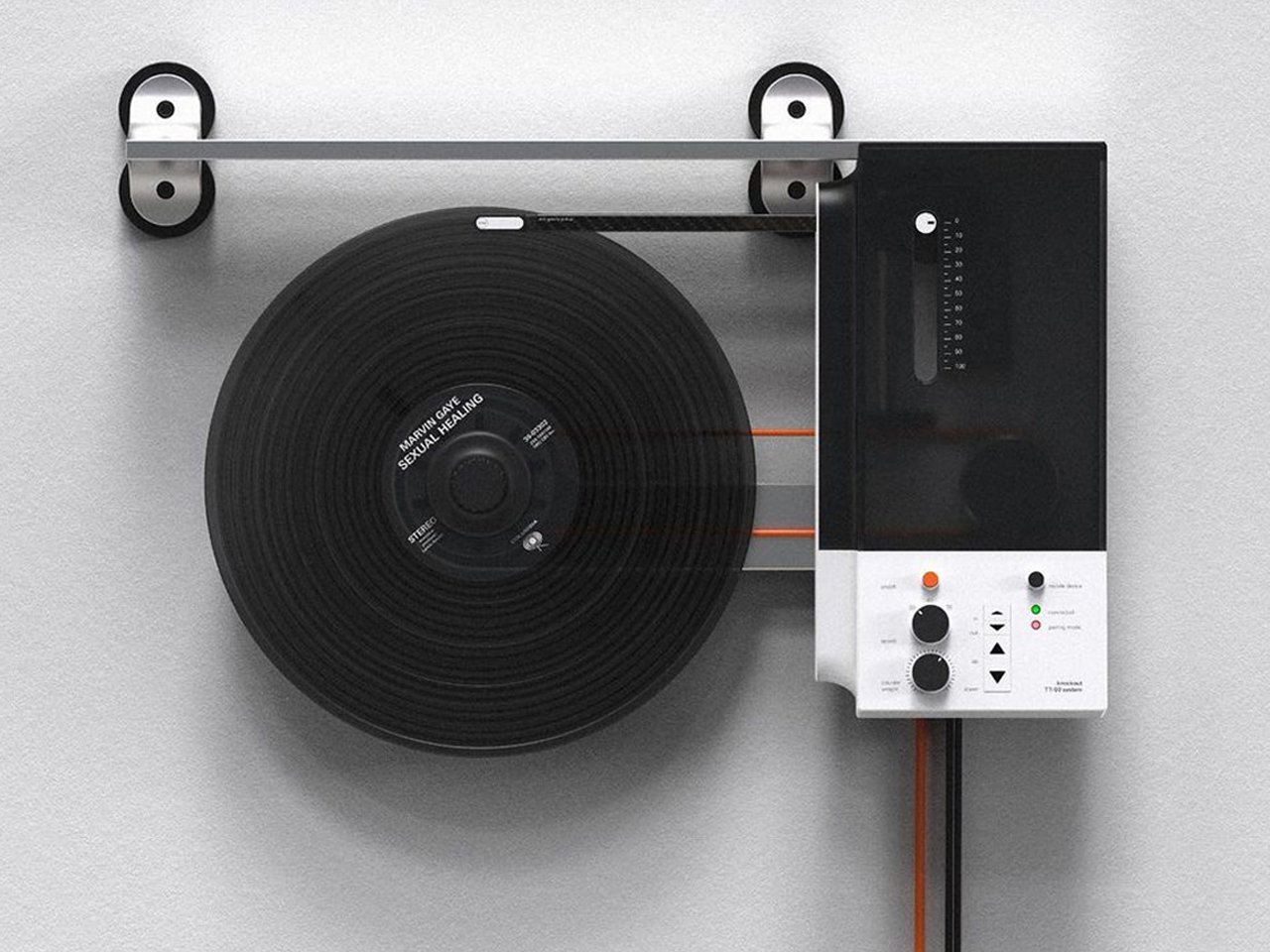Vinyl records evoke nostalgia and hold memories of the past, and in the digital age, they have experienced a resurgence, becoming a popular medium for music lovers, especially audiophiles. As a result, vinyl records are making a strong comeback, with audiophiles now enjoying the unique experience of listening to vinyl records on either turntables or record players. The evolution of recorded music began with the gramophone in the 1870s, followed by the introduction of the first electric record player in 1925. Since then, record players and turntables have evolved to allow you to play vinyl records that cater to different listening preferences and styles. Although turntables and record players are distinct devices, they serve the same purpose of playing vinyl records, but their setup and sound quality differ and affect the listening experience.
Turntable
A turntable is a sleek, minimalist device that is designed to spin vinyl records at the correct speed while the stylus (or needle) reads the grooves and produces sound vibrations. However, it requires additional components, such as an amplifier and separate speakers, to produce sound. While a turntable is focused on accurately reading the vinyl for optimal sound reproduction, it also offers a tailored listening experience. Audiophiles prefer turntables for their high-quality, immersive audio and customization potential, as well as because they allow users to upgrade components to match their preferences and budget. On the downside, assembling a turntable can be a complex process.
There’s a strong appreciation for classic retro style, and the Brad Retro Mk II perfectly captures this with its vibrant, retro-inspired design that combines nostalgic charm with modern functionality. This turntable features a boxy, analog look and a colorful personality with which it not only captures the charm of vintage record players but also meets the needs of today’s audiophiles. Its belt-driven mechanism, three-speed settings, and compatibility with 7-12″ vinyl records deliver authentic analog sound.
The built-in 10W speakers allow one to enjoy music without the need for external speakers, while the option to connect via Bluetooth or a 3.5mm jack provides versatile option for louder listening. A new USB-C power port adds portability and allows one to play music anywhere while on the move. Therefore, the Brad Retro Mk II caters to a variety of tastes, it exudes playful vintage charm along with features like tactile controls and easy connectivity.
For audiophiles seeking unmatched sound quality, Pro-Ject’s Signature 12.2 turntable can be the ideal choice as it offers advanced technology and exceptional craftsmanship. The turntable weighs 80 lbs and the turntable features a high-mass platter over 25 lbs alongside an anti-resonant MDF base made from stainless steel with a weight of 50 lbs. The platter spins on an inverted ceramic ball bearing with magnetic support, while over 100 precision CNC-machined components enhance stability and reduce external interference for exceptional sound reproduction.
The Signature 12.2 delivers deep, immersive audio, revealing new sonic details even in familiar tracks. It features a 12-inch S-shaped aluminum tonearm with a 3-point pivot bearing and removable headshell for easy cartridge swaps. The turntable supports 33⅓rpm and 45rpm speeds and it includes an electronic speed change option for precise adjustments. The hand-painted MDF plinth is coated with 10 layers and reinforced with steel pellets to reduce vibrations, and is complemented by a polished aluminum panel and a sleek piano-black finish.
Record Player
A record player features a compact, all-in-one design that integrates the amplifier and speakers into a single unit and offers a convenient, plug-and-play solution. The record player is perfect for casual listening but it does not provide the rich, high-quality sound that vinyl records can offer which makes it less suitable for audiophiles that seek deeper sound depth. Additionally, record players evoke nostalgia with their classic way of enjoying music which provides a user-friendly, hassle-free option that simplifies the vinyl listening experience. It’s important to note that while all record players include a turntable, not all turntables are record players.
The sleek design of record players extends beyond just playing vinyl as it offers a more refined and immersive experience. For instance, this record player design takes inspiration from architectural precision as it features an aluminum chassis with slats that are reminiscent of modern buildings. These slats add to the visual appeal and serve practical functions. One slat holds the tonearm when not in use to prevent accidents while the gaps between the slats cleverly conceal the controls.
Unlike traditional buttons or sliders volume, speed, and power blend seamlessly into the design, as it offers a unique, hands-on way to engage with the machine. The anodized aluminum body gives the record player a distinctive industrial look that evokes the look of robot arms used in manufacturing. In a world of digital music consumption, this design reintroduces a physical and classic way to enjoy vinyl, and it makes the listening experience more memorable and immersive.
A recent innovation is Oscar Olsson’s TT-90 System wall-mounted record player that blends classic analog with modern digital technology. Designed in black, orange, and white, it eliminates the bulky cabinet-style appearance of traditional players and offers a sleek, space-saving alternative. The vinyl appears to float on the wall, yet spins smoothly beneath the needle to deliver the iconic sound vinyl lovers cherish. The best part about this product is that it removes the bulk of conventional players and adds mobile control functionality.
The TT-90 System can be operated via onboard controls or can be synced to a smartphone for added convenience. The stability concerns of the record player are addressed with rubber packs against the wall to minimize vibration, and a threaded knob securely holds the vinyl while it spins vertically. This record player is visually striking and highly functional with practical design elements for an enhanced vinyl listening experience that offers style and advanced features for audiophiles.
Sustainable Innovation in Design
The use of sustainable materials like bamboo, aluminum, and glass in record players and turntables is a growing trend as consumers and manufacturers prioritize eco-conscious, durable, and environmentally friendly designs. In this example, the Stir It Up Lux Bluetooth Turntable from the House of Marley combines style, sound quality, and sustainability. It is designed as a tribute to Bob Marley with a bamboo plinth, glass platter, and a replaceable Audio-Technica 95E elliptical stylus for enhanced audio performance. The lightweight aluminum headshell and tonearm improve tracking, while the bamboo and glass construction absorbs motor and bearing noise, delivering cleaner, more accurate sound.
Additionally, the turntable pairs easily with speakers and other devices with Bluetooth connectivity. A unique feature is the double-sided cork slipmat that offers one side with simple black cork, and the other with vibrant, Marley-inspired graphics. With a focus on sustainability, it uses bamboo which is one of the fastest-growing plants alongside recyclable aluminum and glass. This turntable offers an eco-friendly yet high-quality listening experience with a touch of Marley-inspired charm.
What is the difference between a Turntable and a Record Player?
Design: A turntable cannot play records on its own but requires separate components which include a speaker and amplifier, while a record player is an all-in-one unit with built-in speakers and an amplifier.
Target Audience: Turntables are ideal for serious music enthusiasts who prioritize high-quality sound, whereas record players are better suited for casual listeners who seek a simple, integrated solution for listening to music.
Sound Quality: Record players usually offer lower sound quality than turntables and have fewer customization or upgrade options since they come with built-in amplifiers and speakers.
Price: Turntables are typically more expensive than record players because of their superior sound quality which makes them a better investment in the long run.
The vinyl revival represents more than nostalgia – it’s a testament to the enduring appeal of analog sound in our digital world. Whether you choose a sophisticated turntable with customizable components or an all-in-one record player for convenience, each offers a unique gateway to experiencing music in its most authentic form. Today’s market caters to every preference, from sleek wall-mounted designs that save space to sustainable options crafted from eco-friendly materials. The choice between a turntable and record player ultimately depends on your listening priorities: audiophiles seeking premium sound quality may gravitate toward turntables, while casual listeners might prefer the simplicity of record players. Regardless of your choice, embracing vinyl connects you to music’s rich history while participating in its exciting future, where tradition and innovation harmoniously coexist.
The post Turntable vs. Record Player: Decoding the Vinyl Experience For the Nostalgic Audiophile first appeared on Yanko Design.

